[page 1]
THE
GEOGNOSY
OF THE
ISLAND ST. HELENA,
ILLUSTRATED
IN
A SERIES OF VIEWS, PLANS AND SECTIONS;
ACCOMPANIED WITH
Explanatory Remarks and Observations.
BY ROBERT F. SEALE.
HONOURABLE EAST INDIA COMPANY'S CIVIL SERVICE. &c.
LONDON:
PUBLISHED BY ACKERMANN AND CO., 96, STRAND.
1834.
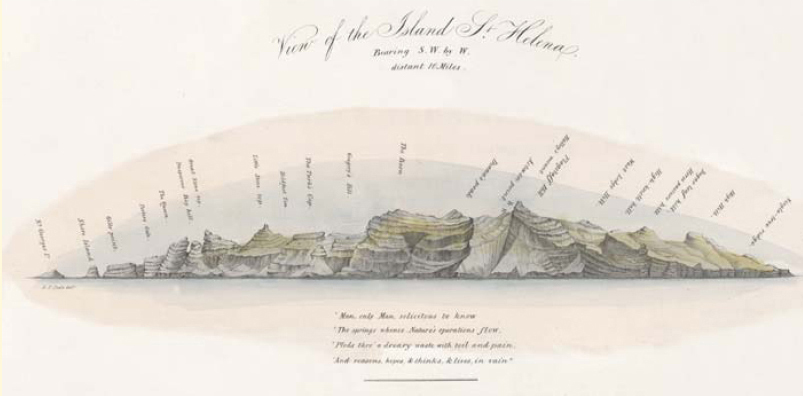
[page 2]
TO
THE HONOURABLE THE COURT OF DIRECTORS
OF THE UNITED EAST INDIA COMPANY,
THIS ATTEMPT TO ILLUSTRATE
The Geognosy of the Island St. Helena,
IS, WITH PERMISSION, DEDICATED BY
THEIR HUMBLE AND OBEDIENT SERVANT,
ROBERT F. SEALE,
ST. HELENA CIVIL ESTABLISHMENT.

The Coast near Thompson's point.
No. 1.
REMARKS
on
The Geognosy of the Island St. Helena,
&c. &c. &c.
[page 3]
Few parts of the world offer a wider or more interesting field, for the inquiries of the Naturalist, than the Island St. Helena; and scarcely any, I believe, is so little known, in a Mineralogical, or Geological point of view. Many as have been the opinions upon its origin, formation, &c., they have mostly (it would seem) been advanced by persons who, from cursory examination of some small portion of the Island, have, perhaps too hastily, drawn conclusions from appearances only. The external parts of the coast, which could have thus been casually viewed, present, amidst the most extraordinary scenery it is possible to conceive, the strangest mixture of unaccountable compounds the liveliest fancy can portray. The more we endeavour to unravel the veil of doubt which envelopes our ideas, the more we are lost in uncertainty; and so bewildered does the imagination at length become, that it is almost impossible to arrange our ideas, upon the objects before us, into any sort of regularity, and we are induced to quit the subject as we found it, dissatisfied either with it, or with ourselves.
However strange, and however unaccountable the outward appearances of this extraordinary Island may seem (and they are no less extraordinary when inquired into), the internal are still more so; and it must be a residence of some term, spent in unremitting research, that alone can set our wayward sentiments at rest with regard to their causes.
Written descriptions of these appearances, however laboured the attempt may be, could never prove satisfactory. This has been the principal inducement for substituting accurate drawings and sections in place of descriptive writing: and although this very humble effort to illustrate the Geognosy of St. Helena may be deemed novel, I trust it will prove as satisfactory in result, as interesting in detail.
The large plaster model of the Island,1 now in the Honourable East India Company's Military College at Addiscombe, which, after many years of infinite toil and anxiety, I constructed from surveys and observations made during a period of fourteen years, furnishes a faithful representation of the surface of the Island: this model, in conjunction with the views now offered to public notice, will, I hope, render the Geognosy of St. Helena more complete than any which has hitherto appeared.
No doubt can exist that the Island is partly volcanic; and notwithstanding the multiplicity of opinions which have been adduced to prove it wholly so, I fear they would seem unsatisfactory, did the supporters of those opinions possess the advantage of contrasting the effects visible with their supposed causes. So far as regards myself, I do not hazard an opinion as to its origin; I offer my observations and remarks to the consideration of those who are more capable of so doing. They may perhaps assist in framing the groundwork for proving, that from the great variety of basaltic columns, and appearances of this character, which are to be met with throughout the Island; from its abounding in limestone hills, and other calcareous matter; from the precipitous nature of its coasts; from the shallowness of the water; from the numerous mountainous elevations which are to be sounded on, (extending upwards of fifteen miles from the main); and from the circumstance that sea sand is nowhere observable between the strata, that St. Helena is either a portion of the wreck of a vast continent, or of an island which was at one time of very large dimensions, and equal in age and components to the continental parts of the world.
[page 4]
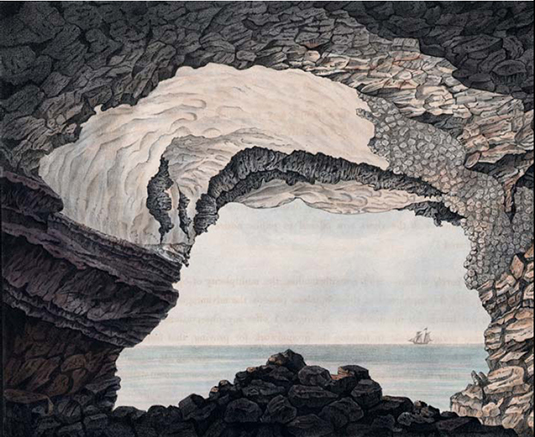
Cavern at Thompson's point.
No. 2.
[page 5]
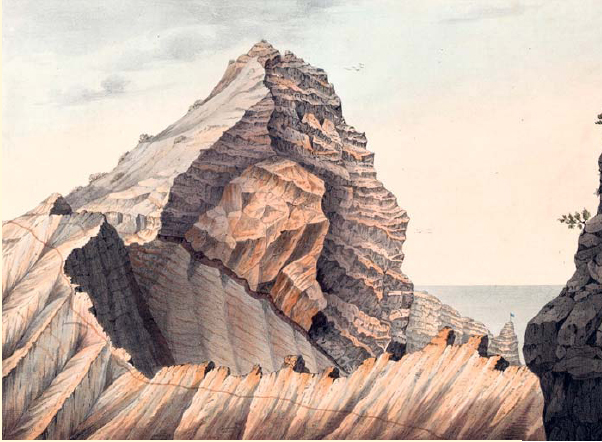
Flagstaff and Barnhills with Sugar-loaf in the distance, supposed to have formed three sides of a Crater. No. 3.
The sudden terminations of strata which are everywhere observable, cannot fail to induce the conclusion that they have been caused by the operations of Nature, which separating the parts now wanting from those remaining, have, by plunging the former into the ocean, produced the precipitous coasts encompassing the Island. In many places along these coasts, one side of the vertical strata may be seen to form the barrier against the sea, extending in length from twelve to fifteen hundred feet, and being in height from four to six hundred and fifty feet, although not more than 1eighteen inches in thickness. They may also be observed running miles into the sea, assuming the appearance of ruined walls, and standing entirely unsupported except at the base. As, however, the formation of these strata could not possibly have taken place under the circumstances of wanting side supports, or of the site, in which they occur, being covered by the sea at the period of their formation, their presence favour the supposition that the existing and gigantic proportions of this Island were never intended solely to bear up and hold together a superstructure so diminutive as that which now remains.
[page 6]
Marine shells being found in large quantities at one thousand nine hundred feet above the level of the sea, may argue in favour of the opinion that from this circumstance the Island had been raised en masse from the bosom of the ocean. If the remains of sea shells indicate that the sea has once existed in the places where these collections have been formed, there must either have been a great recession of the waters of the ocean, or a vast elevation of the mountainous parts of the earth; and as the former is the most probable supposition, the presence of those helices, which are to be met with in three or four parts of the Island, indicate that those parts (at least of St. Helena) existed anterior to the recession of the waters, inasmuch as they are not strata of shells, but depositions which have been made upon several projecting flats on the sides of some of the hills, and, in one instance, upon an extensive plain. The variety of the helix here alluded to, is never found in a living state upon any part of the coast; and it has been said, "that beds of fossil shells which consist of one species only, and are not native to the climate where found, but of very distant regions of the earth, show that the inhabitants of those shells have lived and died in the beds in which they are found."2 I possess an extensive collection of shells from all quarters of the world, but I have not met with one agreeing in character with those now found in a fossil state, and of which an accurate representation is hereunto annexed, together with a section of a hill in which they are deposited.
Upon examining the surface of the Island, as well as the sides of the roads leading through the interior, it will be perceived that decomposition in all its stages is advancing with rapid strides. Rocks,3 which were formerly of the hardest description, and of the largest dimensions, are seen decaying in concentric lamellæ; and others reduced to nodules not exceeding two inches in diameter. This decay is also most distinctly marked on the summits and sides of many of the hills in the eastern division, where the once black and compact vertical strata may be found passing into clays, tinged with every variety of colouring which the oxide of iron is capable of producing. These veins, however, gradually retain more of the original compactness of the strata as they recede from the interior towards the coast, where they remain perfectly free from any indication of decomposition.
The space included between Holdfast Tom and Prosperous Bay Hill is an extensive amphitheatre, formed by hills of great height, the face of which, in many parts, is perpendicular for eight hundred to a thousand feet. The country beyond these precipices is a flat table land, open to the North, but shut up on the East and South East sides by a rising ground; and the flat has been bared of the earth, which had covered it to a considerable depth. The precipitous sides of this vast amphitheatre afford retreats for some of the birds common to the coasts; but in the level or bottom, and buried at various depths, are innumerable skeletons of the phæton ethereus and diomedea exulans, which latter bird, now-a-days, never seeks a resting place in any part of this spacious bosom. Hence it would seem that, in ages long past, these birds in numbers had formed their habitations in the cliffs surrounding the space in which their bones now lay buried; and the rain, which the Almighty ordained should cover the earth, forcing them into their retreats, and bringing down the soil from the upper lands in overwhelming torrents of mud, had swept all before it in one general destruction. The bed, or ossuary, in which these fragments are found, extends about a mile in length from the water's edge, from one hundred to three hundred and fifty yards in an opposite direction, and is from ten to ninety feet deep. Remains of a similar description are found near Sugarloaf
[page 7]
Hill, these must also have been brought from a higher land, now no longer existing; the mass of lime and common earth, which here covers them, taking a direction Eastward, or towards that space between the Barn and Sugarloaf occupied by the sea, and forming Flagstaff Bay; and which, from the corresponding substances and agreement of strata at opposite sides of the bay, must, at one time, have been continuous land. The perpendicular face of two-thirds of this bay, affords the most convincing testimony that some awful revolution in Nature has destroyed the other part, leaving this space of coast a monument of its power, and the wonder of all who behold it.
The stratum, represented in Drawing No. I. (letter m), and which may be seen at intervals, and at various elevations above the water's edge, completely round the Island, protrudes itself through Flagstaff Hill in an Easterly direction (vide No. III.), and appears to have been united to the Barn, in the West end of which a similar disjointed stratum is seen. The different strata of the Barn, with their correspondence of dip, and the materials of which they are composed, so perfectly assimilate with those of Sugarloaf and Flagstaff Hills, that their original continuity can hardly be questioned. It does not seem that this correspondence is the effect of "accident;" it is so perfect throughout that it renders "probability almost certain." The intermediate parts having been detached, has left a break in the land of eight hundred and fifty yards: this break is circular, and is rather less than one-third of the distance, on the land side, from Barn Point to Sugarloaf Point, assuming every appearance of being the remains of a very extensive crater. The annexed is a sketch of that part which now remains, facing the North East.
From Sugarloaf Hill to Flagstaff Hill the coast is extremely abrupt, and of considerable elevation; but between the latter hill and the Barn it is lower, and more easy of ascent. In this space stratification is hardly perceptible, the whole appearing a confused mass, or assemblage of almost every description of volcanic product, but containing more of puzzolana than of any other. Over this portion of the intermediate hill, I conceive those irruptions to have passed, which have left, in the neighbourhood of this interesting spot, so many incontestable proofs of its having been the seat of those volcanic terrors, which in their struggles for ascendancy were eventually annihilated in that destruction they had so unsparingly spread around. At the bottom of that part of the cone which is most distinctly marked, and at thirty seven yards above the level of the sea, there is a flat space, one hundred and sixty-eight yards in diameter, occupied by masses of puzzolanas, lavas, and cinders, where the last effort of subterranean fire seems to have exhausted its indescribable and desolating fury. The inner side of this assumed crater falls at an angle of about forty-five degrees.
[page 8]
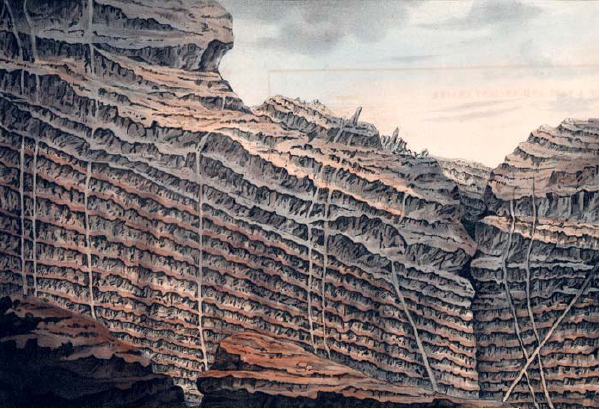
Part of the Coast near Flagstaff Hill. No. 4.
In the vicinity of this spot compact vesicular and spumous lavas abound; and an extensive plain (Deadwood) and the other level lands adjoining, viz. Longwood, Horse-point, &c., are completely coated, at various depths, with a shaggy lava, or scoriæ, of a black, brown, and redish cast, having a steel tarnish of considerable weight, occurring amorphous, but most generally in rounded, tumefied pieces, weighing from one quarter of an ounce to twenty and one hundred pounds. The larger being less compact than the smaller, and proportionably lighter for their bulk. Spallanzani, in describing the scoriæ ejected by Stromboli, says, "Like the greater part of scoriæ, it is not only rough, scattered over with tumours and irregular figures, and everywhere scorified, but it is full of vacuities of round, oblong, and other forms; the internal surface of each of these cavities, is, as it were, coated with dull red varnish, while the rest of the scoriæ is black; its hardness is moderate, its fracture irregular; it gives some sparks with steel, emits a weak, earthy odour, and attracts the magnet." This description of scoriæ, agrees in every particular with that which now covers upwards of two thousand acres of land, to the South East of Flagstaff Hill, (and in those fields, where it does not lay too heavy, the finest crops of corn are produced.)
At the distance of about one hundred and eighty yards from the edge of the supposed crater, in the large ravine which commences here, is a deposition of jet black, heavy, and
[page 9]
other lavas which have followed the course of the ravine, or valley, to the distance of two miles and a quarter. The stream must have been of considerable magnitude, traces of the lava extending from the bed of the valley (which in some places is upwards of forty feet across) twenty-five and thirty feet up the sloping sides of the ravine. In its course it had pursued an Easterly direction towards Holdfast Tom, where, upon the edge of a precipice of eight hundred and ninety feet above the level of the sea, and nearly perpendicular, its last traces are visible. The specimens taken from this lava current are singularly beautiful, and of great variety: and are not to be met with in any other part of the Island.
In support of the position, respecting the site of the extinct volcanic vent, the following extracts from a very interesting work,4 which I had not seen when the foregoing remarks were written, bear upon the point so favourably, that I cannot resist the temptation of quoting them. "The ordinary scoriæ, thrown up by a volcanic vent, usually bear an exact resemblance to those which form on the surface of the current of lava produced by the same eruption, at any distance from its source. But the most striking of these imitative forms, particularly the pear, or bomb shaped, can only be assumed by masses of lava projected liquid to a considerable height in the air; consequently the occurrence of a number of these upon any point proves it to have been the site of a volcanic vent; and this indication of unquestionable evidence, may afford a very serviceable assistance towards recognizing the situation of extinct volcanic vents, where their products have suffered much degradation from time or outward injury.
[page 10]
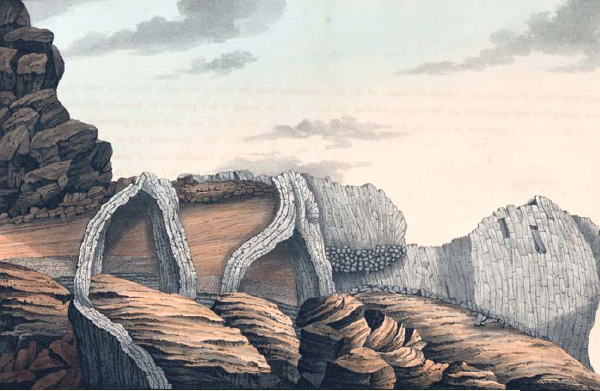
Basaltic Strata in the Barn. No. 5.
"These nodular bombs, being generally more solid than the lighter cellular scoriæ, resist the wasting influence of the weather, and other agents of destruction, much longer and more effectually; and hence it is not unfrequently the case, that in districts of ancient volcanization, the site of an active vent, and consequently the source of a current of lava, may be recognized with absolute certainty when scarcely any thing remains of its original cone."
The common black pumice is everywhere to be found in the neighbourhood of Flagstaff Hill to the Eastward, but I have not met with that which has a silky fibrous appearance in either of the ravines near it, except at their extremities, which are washed by the sea, and then only in small quantities.
In a gully on the South East side of this hill, and about a quarter of a mile from the head of the valley in which the lava current shows itself, rises a very fine spring of salt water, similar in analysis to the Cheltenham; and on the opposite side, or sea-face of the hill, upon the same level, are three springs of fresh water, discharging about four quarts in wet seasons, and less than half that quantity in dry weather per hour.
"Volcanic mountains, of all descriptions, exhibit gullies, or ravines, in their sides, formed either by spaces left between the lava streams, or by torrents of water;" but if we search St.
[page 11]
Helena throughout, the remains of one such stream alone will be found, and that has been described. Every gully, or ravine observable, which commence either on the sides of the ridges forming the valleys, or on the summits of the larger hills, will be perceived to have been effected by rains. The beautifully sloping sides of many of the valleys; their extraordinary depth and large extent; their sinuosities; the extensive flats which are formed on some of their planes; and the total absence, in many parts, of all volcanic traces, are subjects peculiarly interesting.
That the outwardly wild and shapeless mass of rock, which St. Helena seems upon its being approached, should contain the alternation of hill and dale, and the delightful scenes of luxuriant and endless verdure, which, in the interior, everywhere meet the eye, has been the wonder of all who have ever beheld them; not but that scenery far more diversified and enchanting may be viewed elsewhere, but because there is an impossibility in reconciling the interior with its exterior appearances. Here we must consider, that the portion of this singular Island which borders on the sea, can never be subjected to the humidity of the atmosphere, or to the effects of the other decomposing agents which are constantly exerting their influence on the materials of the interior; that every substance composing the hills, as well as those which lay at the bottom of the inland valleys (with the exception of basaltic accumulations), have gradually wasted before their influence; and thus has been produced the variation between external and internal scenery, which strikes the casual observer with surprise, and the more careful with perplexity and indecision.
The effects of this gradual decay, will however be found visibly to lessen as it recedes from the centre, or main ridge of the Island, which is composed entirely of large masses of tabular basalt. Immediately around this chain the soil is many feet deep and humid; it then lessens in depth and loses a portion of its humidity; verdure becomes more diversified; here and there unproductive clays appear; rocks and stones are found in the last stage of decomposition; others partially so; and lastly, we see lavas which are slightly, or not at all affected. The annexed diagram will elucidate my meaning in a more comprehensive manner.
[page 12]
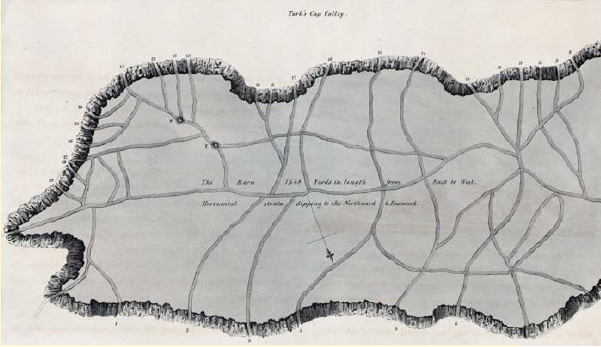
Longitudinal section of the Barn representing the numerous intersections of Vertical strata at 1600 feet above the level of the Sea. No. 6.
Yet, amidst the combined and destructive efforts of the elements, the basaltic accumulations, which assume every shape from the tabular to the scalarlike, remain uninjured; and this indisputable fact, regarding this secondary rock which formation "fills up vast tracts between elevated rocks of the primitive, or transition class," may place the Island St. Helena as near, if not nearer in alliance to the primitive, than the volcanic; but to which of these formations it shall finally be classed, remains still to be decided.
The South West extremity of the Island presents a singularity which I should not omit mentioning:-at the foot of a hill, near Thompson's Wood, is a space of clay land, gradually inclining to a flat centre of about three acres, which is completely studded with immense blocks of basalt. These blocks assume the most fantastical shapes, and seem, as it were, to have been so fashioned by the hands of the rudest sculptors. At a little distance they resemble so many monuments, tombstones, &c.; and hence, the spot has been called the Churchyard. In no other part of the Island are appearances of this sort visible, and these seem the more extraordinary from their being only on the surface, and standing insecurely; and from the spot being surrounded by hillocks of clays, and other earths, in which there are no stones of any description.
The valleys of St. Helena branch from the central ridge of the Island, which is composed of basalt, and has not unaptly been termed the Backbone. It commences at the Ass's Ears, and runs nearly in a half-circular direction Eastward, towards Stone Top. The rock called Speery,
[page 13]
at some distance from the main to the South West, was evidently a portion of this ridge, as were Shore Rock and George's Island to the Eastward. This basaltic chain seems to have withstood the shock of all convulsions, except at its (now apparent) extremities, where those parts, which had occupied the spaces between Speery and the Ass's Ears, and Shore Rock and George's Island, have been destroyed, together with all those extensive tracts which completely encircle the Island, and are now covered by the sea, but upon which soundings at inconsiderable depths are everywhere attainable.
In the numerous examinations of the basaltic chain (which passes from one extreme of the Island to the other), made upon masses that from external appearance seemed to differ in their components, I have not, in any instance, detected any portion of water; but in lavas of the cellular descriptions, where they have been found tolerably compact in their structure, this fluid has invariably, more or less, been present.
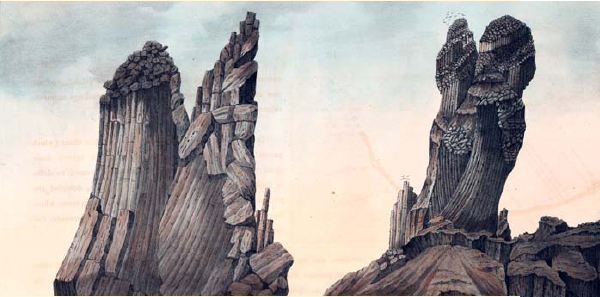
The Asses Ears. Lott's Wife.
No. 7.
The valleys, as I have already stated, radiate from this central elevation, and my idea is, that they have originally been partly formed by the same revolution in nature, which, in its operation of contracting the Island to its present dimensions, opened rents, or fissures in every part of it; that the fissures or chasms, thus opened, becoming frequently filled, or obstructed by the falling materials from their steep or perpendicular sides, were as repeatedly cleansed, and often enlarged, by the torrents of rain-water which constantly collected in the mountains; and that, in this chasm-like state, they remained with little alteration until affected by the waters of the deluge. That, afterwards, the mountainous parts being soonest released from the effects of their watery canopy, would have left the different valleys, which radiate thence (as we now see them), less extensive at their commencement than at their termination;
[page 14]
inasmuch as the receding waters, by continuing gradually to detach larger portions of the fragments from the hills in proportion to its continuance on their less elevated parts, would progressively augment its effects, until the overhanging weight of the superincumbent mass became taken off, by the materials composing the hills bearing equally on their base, when these effects would cease; and those parts of the valleys, which should then be the last freed from their watery covering, would thus become greater in extent than any other, and their bottoms left without the appearance of sinuosity: but the saturation, which the soils must have undergone during the period that the sea so occupied the land, would occasion vast quantities of stones, mud, &c., to slide down the face of the inclined plane, and other detritus to accumulate; these depositions, added to the materials of the gradual abrasion which speedily commenced, and has ever since been going on, have formed the alluvial accumulations, in which the after and more gentle flowings of rain-water have worked the sinuosities now existing in every valley throughout the Island. Had the valleys received their formation from the action of water, unassisted by the effects of subterranean convulsion, the more compact basaltic strata, which intersect the Island, would have resisted this force, and large quantities of debris being gathered on the spots where these checks took place, either lakes, or extensive flats of alluvial soil would now be met with; but as no appearance of this description is seen, it may not be unreasonable to infer that some co-operative force of nature has aided the water in the completion of this no less extraordinary than beautiful work: and that as the latter element approximated to its original level, or to that which it was then ordained and about to occupy, and its operations becoming more passive, were formed those lengthened flats or bottoms of the valleys;5 which, without any very perceptible difference in the elevation of their extremities, extend from the sea very considerably into the interior.
In every valley which I have been enabled to explore, for the purpose of ascertaining whether the strata be traceable without a breach, I have found at the bottom nearest the sea, and extending inwards more or less, that the vertical strata are not connected, but that the sides of the valleys either fall suddenly and perpendicularly, or have a tendency to widen under the debris. In many of our deep but narrow valleys this may satisfactorily be seen, where the extremities of the ravines, adjoining the sea, form coves, some of which are of great depth both horizontally and perpendicularly.6 These coves were worked out by the sea washing the loose materials from the gorge of the rent which had primarily caused the ravine: and such masses of rock, as could not be thus removed, form an arch across the valley, the materials of which become so firmly conglutinated by calcareous earth, that the water from the interior passes over these accumulations as upon a smooth and polished bed.
It would seem that the projecting flats, so singularly situated on the sides of some of the steepest hills, have been formed from certain portions of these hills being of less compact substances than the contiguous parts, and therefore subjected, during the paroxysms of an earthquake, to be deprived of their bulk in proportion to their incapability of resistance; and to continue, from this cause, to lose by abrasion a greater portion of their remaining body, than would otherwise be the case. The sides of such hills as are composed of successive strata of basaltiform lavas, do not present these flats, above which are always seen hollows, or indentations, apparently equal to what we may suppose to be the solid contents of the flats below.
[page 15]
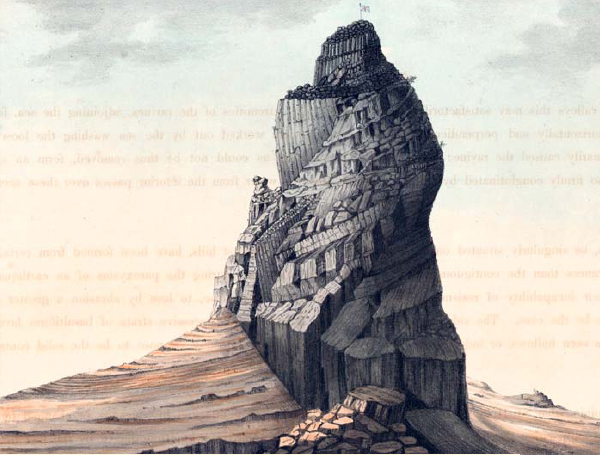
Lott. No. 8.
As appearances certainly favour the opinion that St. Helena did "exist above water before it was attacked by volcanos, or changed by the effect of subterraneous fires or earthquakes;"7 the supposition that it has been contracted in it dimensions, may be strengthened by the fact that Flagstaff Hill, which is two thousand two hundred and seventy-two feet above the level of the sea, and on the North face nearly perpendicular to the water's edge, appears at one time to have been affected by the influence of the same decomposing agents as now operate on the mountains of the interior, being at that period situated, like them, at a distance from the sea. This hill is now verging fast into the same degree of dreary barrenness that overspreads those along the coast; but the traces, which are everywhere observable, plainly indicate that it has been thickly clothed with trees, as well as the whole of the land in its vicinity. The same grasses, the same species of underwoods, which cover the hills of the interior, may here be seen gradually shrinking from the desolating effects of the sea air and drying winds, whose parching influence have already destroyed the greater portion of that herbage which had covered the South, or least exposed side of it; and to the sudden transition from an interior to
[page 16]
an exterior elevation may be attributed the total destruction of that forest, which flourished in wild luxuriance over those places where nothing now is seen but dreary and unsheltered wastes, or
"Rocks resisting the billows and the sky."—GOLDSMITH.
The immense hills of limestone which abound in the Southern quarter of the Island, as well as the inexhaustible springs of the purest water, with which it has pleased the Almighty to bless this insulated spot, may form in themselves peculiar features in its Geology worthy the deepest investigation of the naturalist, as subjects not altogether reconcilable with the supposition of its being "entirely of volcanic origin."
If the parts of the Island, containing lime, had been "raised above the level of the sea, by the same force which had so singularly deranged the face of it,"8 from what cause could the bones and egg-shells become embedded in the situations in which they are now found? If we admit that these masses of lime have been so raised, we must presuppose that a similar catastrophe had submerged them; otherwise, the appearances, now visible, could not have existed. Would it not seem more probable, that those parts of the Island, which contain this lime, were not thus raised from the bosom of the ocean, but that they existed anterior to the Deluge: that the cliffs in the vicinity were, in ages past, the habitations of birds, whose bones are now the only remains of the winged myriads which once flocked to the tottering pinnacles of those basaltic columns everywhere discernible: and that their deposition in the lime has occurred, as well from the recession of the waters of the Deluge from the face of the earth, as from mountain torrents having gradually transferred the lime from a higher to a lower level.
There are four varieties of limestone in the Island; viz. granular, compact, cellular, and earthy. Of the granular there is an incalculable supply. The compact is in lesser quantity, protruding itself through the basaltic formations of the sides and bottoms of some of the ravines in Sandy Bay; it is heavy and much veined; receives a polish; yields about five-eighths of pure lime, and bears a resemblance to the limestone of the Alps. This limestone is sparingly studded with particles of the formation through which it appears to have been protruded. The cellular has only been discovered in a mass of strong clay between Flagstaff and Sugarloaf Hills, on opening the ground the stone is found in nodules of various sizes, of a dark brown colour, and invariably divided into two or more cavities equal to about one-third of the bulk of the nodule; these cavities are coated with a substance resembling the roes of the smaller fishes, slightly transparent, and of a lighter colour than the exterior part of the nodule. This limestone, which appears to be peculiar to the Island, is accompanied in its bed with lenticular gypsum and fossil helices, the clay resting on a basis of basaltiform lavas. This collection of limestone is on the brink of a precipice six hundred and fifty-six feet above the sea, and appears to be the remains of a once extensive bed, the Eastern part of which has disappeared, (vide right-hand side of View, No. IV.) The earthy limestone is found in various places in the Eastern district.
On the Island of Ascension there is but one solitary and trifling run of fresh water; and, notwithstanding St. Helena is very little larger than that Island, there are here upwards of two hundred and forty-five springs of the purest water; two hundred and twenty of which, by the
[page 17]
mean of three measurements, produce seventy-eight thousand gallons per hour; and thirteen of these springs possess the property of yielding one thousand and thirty-nine gallons of water per hour; more in the dry than in the wet seasons.
It may not be uninteresting here to remark, that in all that space of land in the vicinity of the lava current, and to which the effects of the once active, but now extinct volcano may be supposed to have extended, and which space is equal to one-twelfth of the whole superficial extent of the Island, there is not the slightest indication of fresh water, excepting the trifling quantities attainable on the sea-face of Flagstaff Hill.
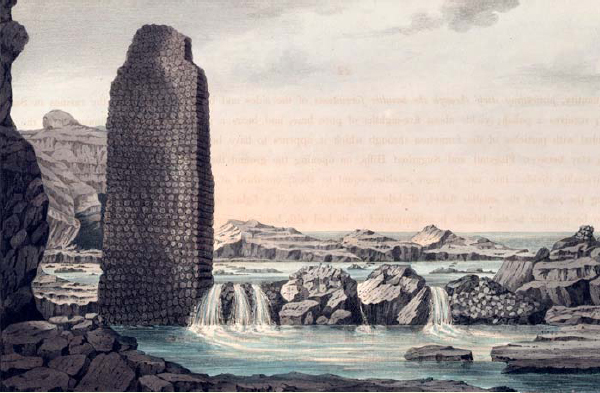
The Chimney. No. 9.
[page 18]
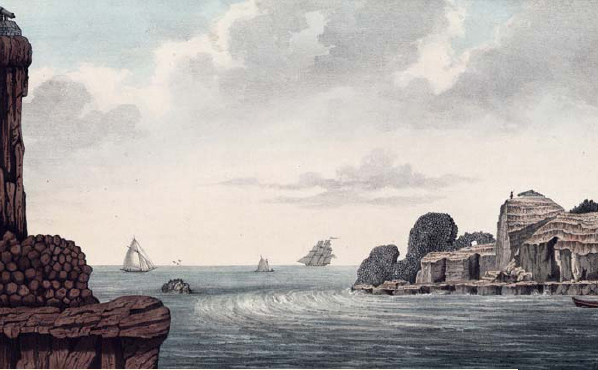
Sandy Bay. No. 10.
If an island, "completely of volcanic origin," such as Ascension is represented, possesses but one diminutive stream of fresh water, is devoid of limestone and other calcareous matter, and be perfectly barren, what ought we to infer with regard to St. Helena? From the never-failing and superabundant supply of water which it affords; its inexhaustible quantities of lime and calcareous substances of almost every description; its never ceasing and most luxuriant verdure; its indigenous trees and shrubs; and from the circumstance of that portion of it, which possesses so scanty a supply of water, bearing the most unquestionable proofs of its being the site of a volcano; may we not infer, that the other portions have never been affected by such causes as could have produced the Island of Ascension? Wanting, as it does, in comparison with St. Helena, all those bounties which have so unsparingly been lavished on this insulated spot, it cannot be reasonable to suppose that the same causes which raised one produced the other. If such were the case, they would be similar in components, in regular and diversified strata; they would assimilate in hill and dale; in trees and shrubs; in the luxuriance of verdure; and in every feature, which two islands irrupted under circumstances and causes similar, could bear to each other.
In concluding these observations upon such points as have appeared to me to be at variance with the generally-received opinion, as to the origin of St. Helena, I feel that I have not expressed my ideas in the manner an undertaking of so much interest deservedly merits: I have simply put them together, as they occurred, in the hope that they may excite in the
[page 19]
bosoms of some, who possess the ability to do that justice to a subject which is beyond my reach, a desire to reconcile those difficulties and doubts which cannot fail to arise in the mind of the naturalist, who carefully compares the structure of this Island with such as are known to be universally of volcanic origin. Rendered as extraordinary by its Geological singularities, as it is by those political events, which caused it to become the "prison house" of that man who thought the world too circumscribed for his ambitious views, St. Helena, perhaps, contains within its ironbound cliffs, a gem of information which, in the hands of the scientific geologist, may assist in throwing some additional light upon the structure of the globe.
Subjoined is enumerated the several minerals which are common to the Island; the various specimens of which are deposited in my Museum:—
| IRON … | Variety, strongly magnetic. |
| Pea iron ore. | |
| Reddle. | |
| Meadow iron ore. | |
| HEPc. PYRITIES | Variety, earthy. |
| COPPER DITTO | Ditto, lamellar, irredescent. |
| CORUNDUM | Ditto, rhombic. |
| QUARTZ | Massive and compact. |
| Crystallized, exhibiting the primitive form. | |
| Ditto, in six-sided prisms aggregated. | |
| Ditto, on six-sided prisms of calcareous spar. | |
| Aventurine. | |
| Pseudomorphous quartz. | |
| Hornstone. | |
| Ditto, variety, chert. | |
| Chalcedony mammillated. | |
| Ditto, with concentric veins. | |
| Porcelain jasper. | |
| Common ditto. | |
| Agate ditto. | |
| Fortification ditto. | |
| Landscape ditto. | |
| Agate breccia. | |
| Sinopal. | |
| Quartz, in low six-sided pyramids. | |
| Agate jasper reniform. | |
| ZEOLITE | Variety. |
| PITCHSTONE | Pumice, variety, fibrous. |
| HORNBLENDE | Basaltic. |
| Ditto, in dodecahedrons with isosceles triangular faces. | |
| Ditto, in six-sided prisms, with two angles truncated. | |
| CHRYSOLITE | Augite, in eight-sided prisms. |
| Coccolite massive. | |
| BASALT | Clinkstone. |
| Columnar. |
[page 20]
| Cavities covered with crystals of calcareous spar and iron pyrites in cubes. | |
| Ditto, containing quartz in cubes; the upper edges of the angles truncated, and forming rhombs. | |
| Ditto, containing lenticular selenite. | |
| Ditto, containing cube spar. | |
| Variety monilliform, detached. | |
| LIMESTONE | Six-sided pyramid (calc. spar). |
| (calc. spar) | Ditto, summit acuminated by three planes. |
| Double three-sided pyramids, bases forming zigzag line. | |
| Ditto, in twin crystals. | |
| Nine-sided pyramids, summits acuminated by three planes. | |
| Six-sided prisms, truncations meeting and forming three-sided acuminations. | |
| Double nine-sided pyramids, bases forming zigzag line. | |
| Six-sided prisms, alternate faces broader, terminal planes, forming six-sided pyramids. | |
| Pearl spar in six-sided pyramids, fascicular. | |
| Six varieties. | |
| Coralloid. | |
| Oolite. | |
| STALACTITE | Massive. |
| Reniform. | |
| Tubiform. | |
| Mammillated (green). | |
| Ditto (white). | |
| Zoned. | |
| PEASTONE | Variety. |
| GYPSUM | Earthy. |
| Granular. | |
| Compact (used in sculpture). | |
| Fibrous. | |
| Plumose. | |
| Tubular. | |
| Mammillated. | |
| Lamellar. | |
| Asicular. | |
| Lenticular. | |
| Stellated. | |
| Radiated; and many other varieties. | |
| LAVAS, &c | Spungeous, with hornblende imbedded. |
| Ditto, with crystals of calcareous spar. | |
| Cellular, five varieties. | |
| Botryoidal. | |
| Compact. | |
| Heavy slaggy. | |
| Ditto, in bombes, with a steel tarnish. |
[page 21]
| Ditto, in drops, with a steel tarnish. | |
| Sandstone (very loose grain). | |
| Common opal. | |
| Wood ditto. | |
| Basalt porphyry, with augite crystals. | |
| Vesicular wacke. | |
| Rocksalt, stalactitic. | |
| Greenstone (trap). | |
| Rottenstone. | |
| Numerous specimens of vertical strata. | |
| Four varieties of marls (inferior). | |
| Twenty-five varieties of clays. |
LONDON:
PRINTED BY REDDING AND TURTLE, 30, ARUNDEL STREET, STRAND.
Footnotes
1. "To Sir G. Robinson, Bart., Chairman of the Hon. East India Company, &c. Dear Sir, In my last visit to Addiscombe, it was with the greatest pleasure I inspected the Model of St. Helena, lately deposited there by order of the Hon. Court. I assure you I consider it a most valuable and interesting illustration of that important point; and I feel so fully convinced of the fidelity of the details, that I cannot resist expressing to you my admiration of the patience and instruction which has produced this beautiful and elaborate piece of workmanship, &c. (signed) A. Dickson, Colonel and Insp. E.I.M.S., Royal Arsenal, Woolwich, October 31, 1826."
2. Whitehurst.
3. Dark, grey, compact, ponderous; containing olivine, augite, basaltic horneblende, magnetic iron ore, &c.
4. Scrope on Volcanos.
5. Such as James's, Rupert's, Sandybay, and other valleys exhibit.
6. At Sandy Point, on the Eastern coast of the Island, the constant rollings of the sea will be seen to enter one of these coves, yet no back wave returns; and the roaring influx will be heard until the sound becomes imperceptibly lost in the distance.
7. Forster.
8. Dr. J. Arnott, M.D. St. Helena.